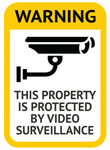By Mary Fouts
 Loss prevention has entered the digital age. Some of the latest advancements to stop shoplifters are security cameras that can be monitored from a cell phone or home office, specialty tags to stop shoppers from buying garments with the intent of wearing them once and returning them, and tags that beep if a pin is tampered with, a lanyard is cut, or the thief tries to grab an item and run.
Loss prevention has entered the digital age. Some of the latest advancements to stop shoplifters are security cameras that can be monitored from a cell phone or home office, specialty tags to stop shoppers from buying garments with the intent of wearing them once and returning them, and tags that beep if a pin is tampered with, a lanyard is cut, or the thief tries to grab an item and run.
Security Cameras
A variety of security cameras exists, from expensive ones that rotate and zoom to inexpensive versions that are stationary. The cheaper versions available on the Internet are more like disposables, and may only be good for about a year. The cameras that need to be wired have much better picture quality and reliability, while the wireless ones that use a lot of bandwidth are not as clear or reliable. These can be very handy though, since you do not have to wire them. A business should install a wired camera, in addition to one or two wireless cameras in strategic places. If connected to broadband wireless, some of the newer software that runs the cameras can be accessed through a cell phone or home computer. Newer software matches cash register receipts with the camera showing the cash drawer. This is designed to stop sweethearting, or when employees sell their friends something for less than the current price, or give them an extra item. Checkpoint and ADT are good sources for these types of cameras.
Specialty Tags
Wardrobing is another criminal act that caused an estimated $8.9 billion in retail losses in 2012. Wardrobing is when someone buys an expensive item with the intent of using it once, and then returning it for a full refund.
Wardrobing is another criminal act that caused an estimated $8.9 billion in retail losses in 2012, according to the National Retail Federation, with $2.9 billion of that occurring during the holiday season. Wardrobing is when someone buys an expensive item with the intent of using it once, and then returning it for a full refund. In the past, this has been a very hard crime to address. Now there is a tag manufactured by WG in California, at the urging of Bloomingdales, to stop this crime. The B-tag is placed in a prominent place on the front of the garment, and is left there at checkout for the customer to remove at home. The store’s return policy states that the B-tag must be in place in order to return the item. The person can take the item home, try it on, and show it to friends and family. The shopper can then decide to keep the garment and remove the B-tag, or leave the tag on and return the item. Although the price is significant and the minimum purchase quantities rather large for smaller stores to afford the tag, it will gain popularity as the price comes down and the minimum order is reduced.
Tags
Newer tags on the market include two-way, three-way and four-way tags. These tags contain a battery and a ringer. The two-way tag rings the security system if the pin is tampered with, the three-way tag rings if the lanyard is cut on the tag, and the four-way tag rings if someone tries to run from the store. Most thieves are unnerved, not only because the towers at the door ring, but because the tag on the garment continues to ring as they run out the door. Usually they will ditch the item, rather than be caught with it beeping in their hands. These tags, too, can be a bit pricey, but are well worth the expense if you are in a high crime rate area, or sell high dollar items.
